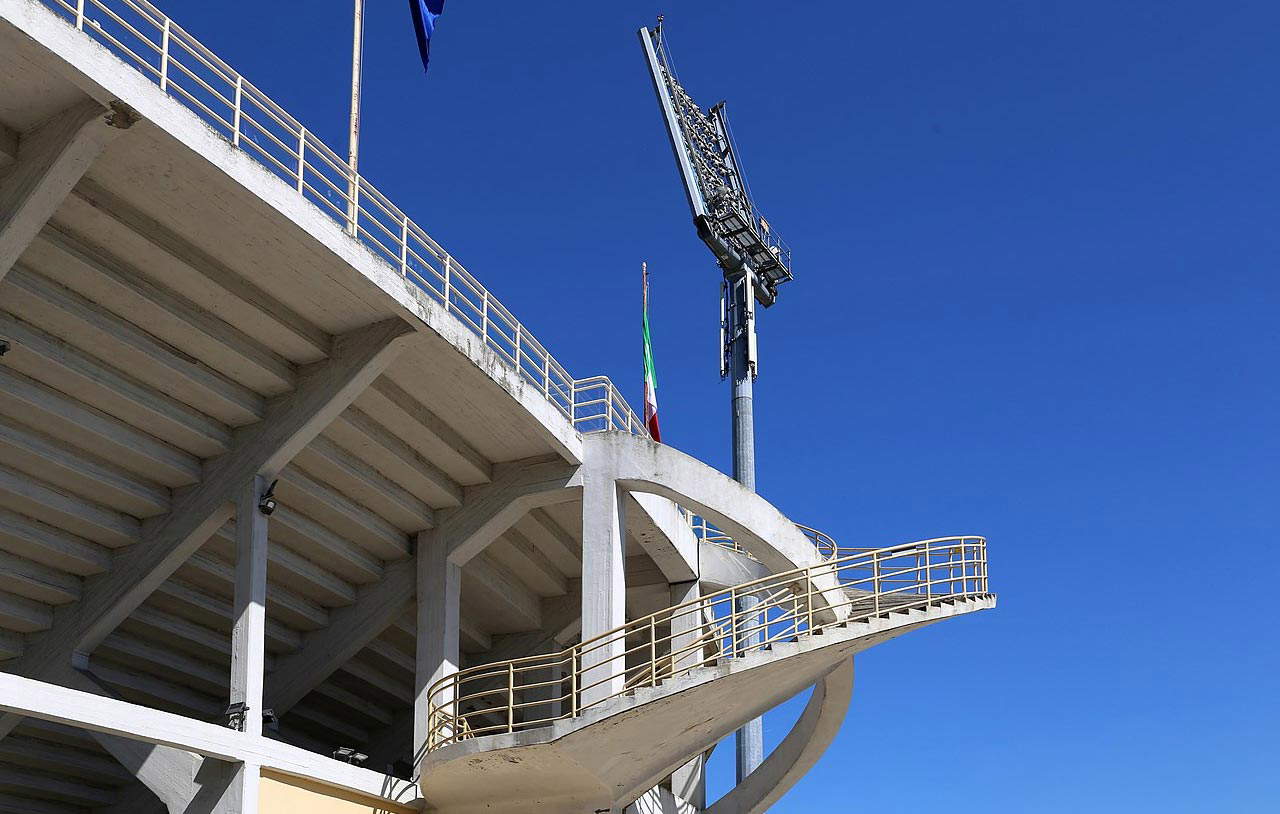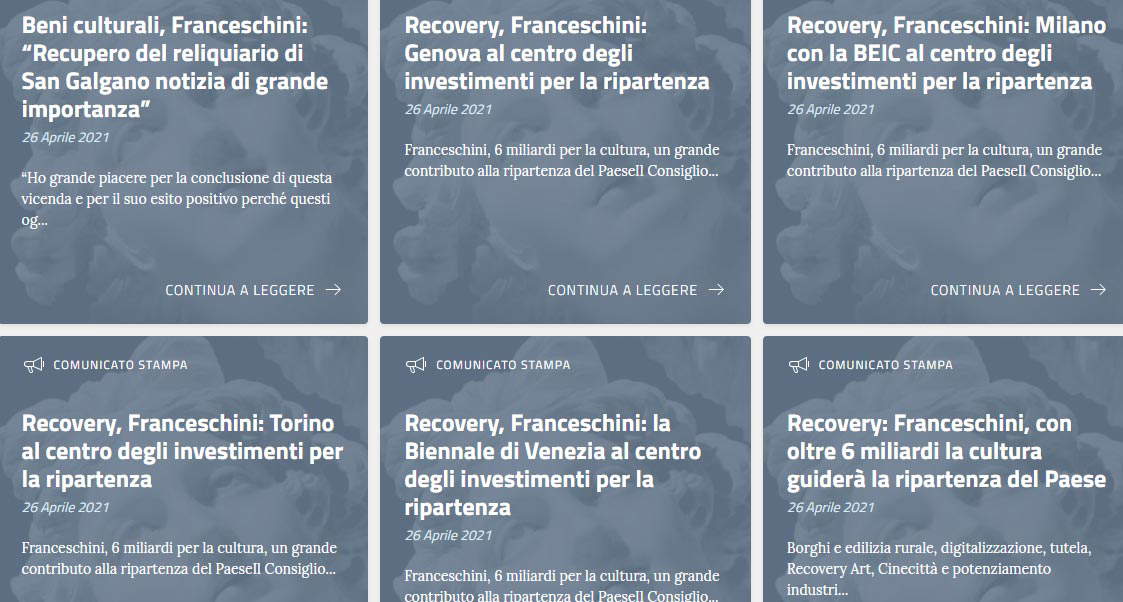A little more than six and a half billion euros is a figure of substantial proportions for the culture sector: the 6.675 billion that the National Recovery and Resilience Plan (NRP) will make available to culture corresponds to a little more than three annual ministry fiscal years. These are resources that will bring benefits: however, reading the plan and the massive amount of press releases that have accompanied it since its approval in the council of ministers, it is difficult to be satisfied, and not only because of the size of the resources, which, when compared to the total amount of the PNRR (222.1 billion, of which 191.5 from Next Generation EU funds and the others from complementary funds), represent exactly 3 percent of the total, but also and above all because the plan has very little that is innovative. The first point to note is the role the plan assigns to culture: the sector does not seem to be seen as a lever to enact processes of social transformation, to improve the country’s competitiveness and its ability to innovate, to support research. If anything, the government’s priority seems to be to invest in culture as a natural vehicle for boosting tourism.
Of course, one does not deny the undisputed economic value that tourism holds for Italy (yet poorly acknowledged by the PNRR, given that the sector receives barely two billion), nor does one want to deny that the sector has suffered from the restrictions put in place to cope with Covid-19, nor that decentralizing flows to combat the phenomenon ofovertourism is a priority (and the plan must be credited with recognizing this), but it can only seem reductive to focus most of the effort on embarking on a journey back in time, reverting to “a heritage paradigm that places its focus almost exclusively on the enhancement of local resources,” as Roberta Capozucca has well written in Sole 24 Ore. In the plan, there is talk of “enhancement of cultural and tourism heritage” seen above all “as a function of promoting the country’s image and brand.” A “regeneration of tourism and cultural heritage,” the description of the plan goes on to reverse the priorities, which will be achieved “through a broad program of measures to restructure key tourism and cultural assets.”
The investment plan focuses mostly on the enhancement of cultural heritage in its dimension of added value of tourist facilities: this is, for example, the logic to which the entire “National Plan Borghi” responds, which will bring more than a billion euros to the less central places (Minister Dario Franceschini, in presenting it, insistently spoke of the Apennine villages, as an example) to support the recovery of their cultural heritage and the “revitalization” of the socio-economic fabric of these places. Revitalization as intended by the NRP, however, is only that related to the tourism supply chain: it speaks of entrepreneurial initiatives such as new modes of accommodation and the revitalization of traditional crafts such as handicrafts “favoring the preservation of the landscape and traditions.” In the plan, therefore, there is talk of redevelopment of public spaces, creation of “small cultural services also for tourism purposes” and “new itineraries” and “guided tours,” as well as financial support for cultural, creative, tourist, commercial, agribusiness and craft activities. It is a pity that the entry dedicated to the villages in the more than two hundred-page plan does not mention, for example, digital and technological infrastructure or investments to encourage the birth of entrepreneurial initiatives not necessarily related to tourism: the image that emerges is that of an Italy of cities, which can afford to innovate and keep up with the rest of Europe, and an Italy of small towns destined to remain entirely dependent on tourist flows, with no possibility of diversification.
However, even if one wants to consider culture exclusively from a tourism perspective, one cannot help but notice the strong imbalance with which funds have been allocated. Of course: some of the funds will go to fuel measures that have been awaited for years. For example, one can only welcome the 800 million euro fund that will be used for theearthquake-proof upgrading of churches in the Fund for Buildings of Worship, for the creation of the “Center for the control and monitoring of Cultural Heritage for the safety of Italian cultural sites,” and for the Recovery Art Conservation Project (although one has to wonder why a name in English was chosen), aimed at the creation of five temporary warehouses for the protection of cultural property in the event of natural disasters, such as that of Santo Chiodo in Spoleto. So are the 300 million euros for the removal of architectural barriers and the equal sum in favor of improving the energy efficiency of cinemas, theaters and museums. Against these expenditures, however, there is one-fifth of the PNRR funds, or 1.46 billion euros, concentrated on just fourteen projects, the so-called “major cultural attractors,” a container where everything ended up inside, with projects unconnected to each other and not even connected to the rest of the plan: from an unspecified route for “historical trains and cultural itineraries” to the redevelopment of Florence’s stadium, from the upgrading of the Venice Biennale to Turin’s Po River Park, as well as a series of projects that mostly insist on large cities and that for the most part do not exactly appear to be priorities. Or at least, they are not compared to investments of another kind: it will therefore be necessary to remember that the PNRR reserves just 455 million euros for the creative and cultural industries, including 300 for Cinecittà and 155 for the “digital and green transition” of sector operators.
 |
| The stadium in Florence. Photo by Francesco Bini |
 |
| Triumphalist releases on major cultural attractions |
Yesterday, on Open, Federico Bosco was pointing out that, in this sense, France, in its “Recovery Plan,” has adopted a completely different approach than ours. While investing in absolute and percentage terms a smaller amount than Italy, France has allocated most of its resources to the cultural industry and to the social promotion of cultural activities. Of course, due proportions must be made: in Italy, restorations, recoveries and earthquake-proof improvements are strictly necessary, since the risk of natural disasters is higher in our country than in France, but it is also true that the France Relance plan does not appear to be undermined by strong imbalances like the Italian one, and resources for cultural industries are better distributed, with measures aimed at fostering artistic creation, live performance, higher cultural education, the book industry, the printing industry, and the film industry.
There are sectors of culture that have been completely left out of the PNRR: I am thinking, for example, of two sectors of excellence in Italy,publishing andcontemporary art, for which special measures have been thought of beyond the Alps, while they have not even been mentioned in our PNRR. In France, 30 million euros have been allocated for a public “grande commande artistique”: in Italy, not even that, despite the fact that several solicitations to that effect had arrived, and despite the obvious benefits that a New Deal of art would have brought to the public and to the supply chain, especially if with intersectoral interventions on strategic sectors (health, environment, research). No support either for encouraging Italians to attend culture, something that France, on the other hand, albeit timidly, is attempting to do with a plan for books that includes, among its main objectives, the purchase of volumes for public libraries, an operation reserved for younger readers, and investments to revitalize the bookstore sector (another forgotten sector of the Italian Recovery Plan).
Culture could therefore have been at the center of a far-reaching process of transformation and social and economic inclusion, but it was preferred to prepare a plan almost without discussion, characterized by a very disharmonious distribution of resources and by an old and outdated vision of culture, or so it appears from much of the plan. Thus, at least theexcessive triumphalism with which the Ministry of Culture presented the plan could have been avoided. Or rather, a part of the plan, since the ministerial communication focused almost exclusively on the major cultural attractions, with a series of communiqués all identical (only the name of the site changed) on the fourteen projects, all presented as “at the center of investment for the restart” (evidently this “center” must be very extensive). Otherwise, only a terse statement from Minister Franceschini: “culture will lead the country’s restart.” Even with all possible optimism, with 3 percent of resources it seems very difficult to see culture playing a leading role.
Warning: the translation into English of the original Italian article was created using automatic tools. We undertake to review all articles, but we do not guarantee the total absence of inaccuracies in the translation due to the program. You can find the original by clicking on the ITA button. If you find any mistake,please contact us.